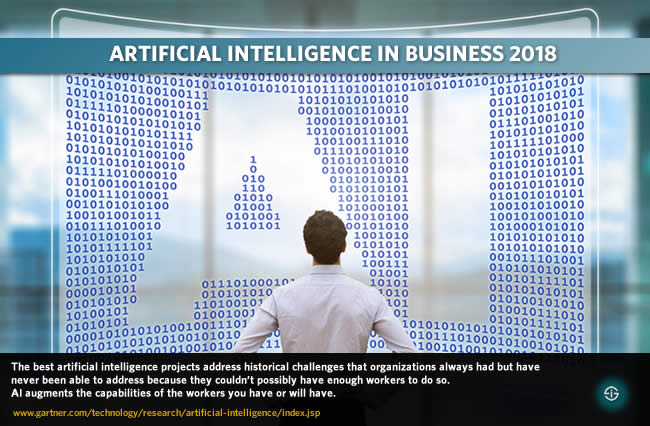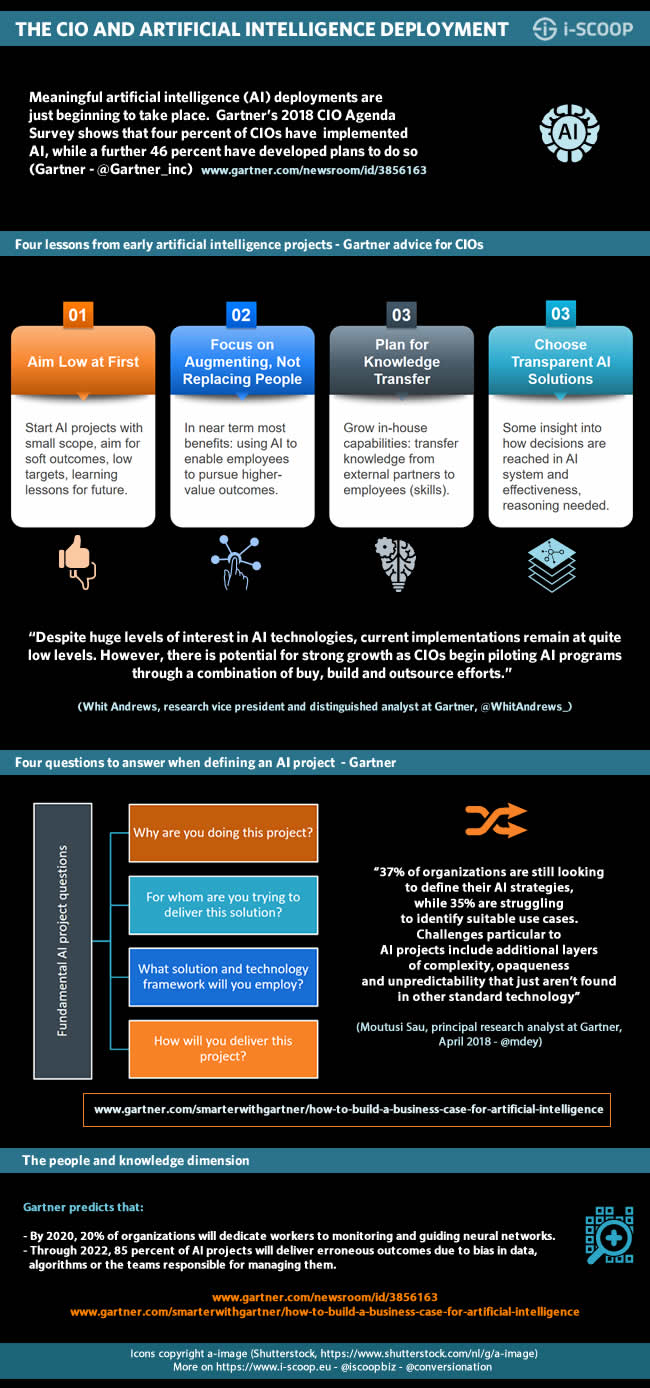Although the interest for leveraging AI (artificial intelligence) in business is high, AI adoption is still low and as far as artificial intelligence in business is concerned we’re about to see a growth in ‘meaningful’ artificial intelligence deployments, Gartner said in February 2018.
Do note the term meaningful. Gartner states that according to its 2018 CIO Agenda Survey four percent of CIOs have implemented artificial intelligence thus far. However, 46 percent of CIOs developed plans for AI implementation.
At the same time, however, ample concerns remain for CIOs. End 2017, in the scope of a survey on the changing role of the CIO, Gartner found that cybersecurity and artificial intelligence are perceived as important gamechangers in the way CIOs will do their job in a not so distant future.
4 percent of CIOs have implemented AI, while a further 46 percent have developed plans to do so (Gartner)
Pain points for AI business implementations: the CIO view
From an implementation viewpoint, artificial intelligence was cited as the most problematic to implement, followed by digital security and the Internet of Things (IoT).

As Gartner’s Andy Rowsell-Jones puts it in the press release regarding the changing role of the CIO: “CIOs are increasingly adopting AI in their organizations. Predominantly, AI is being used initially, either to boost the customer experience or to fight fraud”.
Among the main pain points why CIOs find AI hard to implement: the need for new skills, some of which are really hard to find. The same pain point exists on the level of IoT and digital security (and ample more areas where especially data science skills are required).
On top of skillsets and the need to create artificial intelligence business and technology competencies other concerns, among others include:
- Being able to understand artificial intelligence, its use cases and how to apply it, while making the case with the board.
- Seeing beyond the hype and confusion regarding AI and knowing how artificial intelligence can, for instance, enhance customer experience, help the organization to become more agile and efficient, save costs and drive digital transformation.
- Data privacy, especially when the personal data of children and highly sensitive data are involved.
Despite huge levels of interest in AI technologies, current implementations remain at quite low levels. However, there is potential for strong growth as CIOs begin piloting AI programs through a combination of buy, build and outsource efforts (Whit Andrews, Gartner)
These main AI concerns are pretty universal as turns out when seeing how Gartner analysts found them.
Understanding, skills, seeing the use cases, in other words, getting more educated, seems to top the list overall, even on the level of data privacy and in more specific concerns such as the lack of a documented explanation for the output of models created using deep neural networks, cited by Van Baker as a top concern.
Gartner advice for CIOs in starting to deploy artificial intelligence in business
These obstacles bring us back to Gartner’s February 2018 press release on the plans of CIOs with regards to those meaningful AI deployments.
Based upon its research and the mentioned findings, Gartner found four lessons regarding the implementation of AI in organizations, among others also looking at the AI projects of early movers.
Begin by aiming low with your AI projects
Given the mentioned facts that many CIOs and thus organizations still have a learning curve ahead of them and need to better understand artificial intelligence business benefits (although AI is of course present in applications which nowadays somewhat fall out of the scope of IT, think marketing, AI in sales or AI in customer service, among others), acquiring experience and learning lessons, just as those first movers did seems like a good idea.
However, at the same time one of course needs to achieve a purpose. In both senses Gartner advises to aim low at first. When we compare this with other technologies, such as IoT indeed, this would typically start with a limited project scope and purposes that are limited to improvements in areas of low-hanging fruit such as improving customer experience or enhancing a process.
Also in digital workplaces AI is increasingly leveraged for business purposes in the employee efficiency and engagement scope.
Focus on augmenting people
The replacement of people by artificial intelligence and related technologies such as robotics, for instance in Industry 4.0 and smart manufacturing but certainly not there alone, is one of the most talked about topics.
While for organizations automation and less overhead really always has been a goal (what happens when you bring in an advanced document scanner in an organization whereby there is a reduction of preparation and post-processing time on the labor level?) it’s probably better to drop the job replacement mentality and look at how artificial intelligence can augment worker’s capabilities to avoid resistance but also to align with business reality of AI as it is, in most cases a decision-enabler and indeed augmentation of workers.
The best artificial intelligence business projects address historical challenges that organizations always had but have never been able to address because they couldn’t possibly have enough workers to do so. AI augments the capabilities of the workers you have or will have as Whit Andrew puts it in a video.
Plan for knowledge transfer
Of the skills that lack most, data science skills are cited most frequently. It is essential to make sure that during AI projects there is a knowledge transfer from the partner to the organization in this regard.
In the end, AI also feeds of data and results in actionable data. On top of being able to understand, manage and exploit data it is key to make sure the right data are fed to the AI engine in order to get the right outcomes. This is key and needs to be understood in the organization as part of that knowledge transfer. Gartner predicts “that through 2022, 85 percent of AI projects will deliver erroneous outcomes due to bias in data, algorithms or the teams responsible for managing them”.
Teaching AI to make unbiased decisions as in Accenture’s Citizen AI report, which we covered previously could be added here.
Select the proper AI solutions in the initial stages
This is not exactly how Gartner puts it. The research firm means that, in this stage, it’s mainly important to choose transparent AI solutions: there needs to be an insight into how the AI engine comes to specific decisions and, even if understanding all aspects of an advanced analytical model (think deep learning, for instance), it is necessary to understand it through that degree of transparency.
Gartner also mentions this need in the scope of legal and regulatory requirements, for instance. As Gartner’s Whit Andrews puts it: “Whether an AI system produces the right answer is not the only concern. “Executives need to understand why it is effective, and offer insights into its reasoning when it’s not.”
Building this into a service agreement is one way.
Artificial intelligence in business: AI as a foundation in projects, applications and integrated applications
As far as artificial intelligence projects are concerned it’s pretty much the same story as in all technologies with the additional fact that for many CIOs it is still relatively early days: move in a staged approach, from strategy and evaluation to implementation, deployment and learning the needed lessons to improve and for next stages.
And when starting define a problem that can be solved or benefit that can be realized with AI, frame the solution, have a model tested and developed and deploy, taking into account the mentioned concerns and priorities Gartner (and others) see and recommend.
In general, it’s best to start AI projects with a small scope and aim for ‘soft’ outcomes, such as process improvements, customer satisfaction or financial benchmarking (Whit Andrews, Gartner)
You probably noticed in the beginning how the percentage of CIOs preparing for AI implementation is high. We see similar findings pretty much everywhere, also in the predictions regarding the AI use cases where most spending is poised to occur.
There is of course a reason why Gartner put artificial intelligence, or better the AI foundation, with AI being a foundational component of pretty much all applications we’re about to see changing (examples include AI in ERP, AI in corporate performance management and more), all platforms and all services, from digital twins to AR and VR, in its Top 10 strategic technology trends for 2018, along with subsidiary trends: intelligent apps and analytics and intelligent things (which come with more emanations such as conversational interfaces and more).
Artificial intelligence in business is here. Now get started with a staged approach.

Top image: Shutterstock – Copyright: NicoElNino – All other images are the property of their respective mentioned owners.

